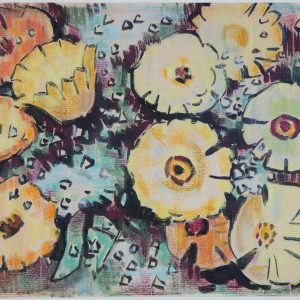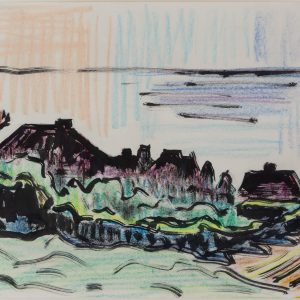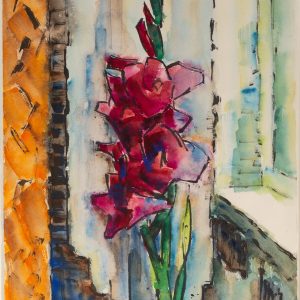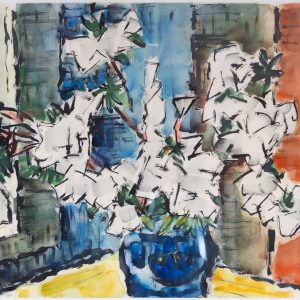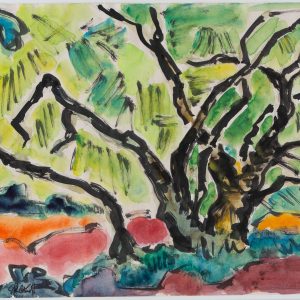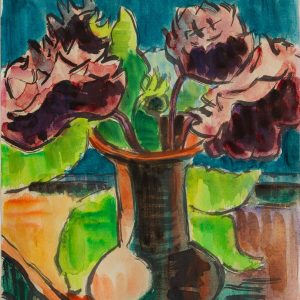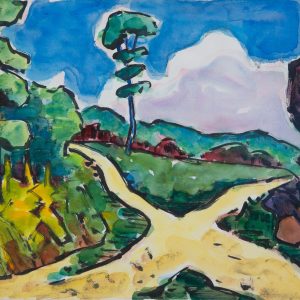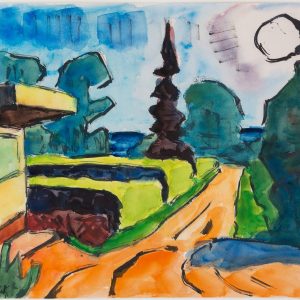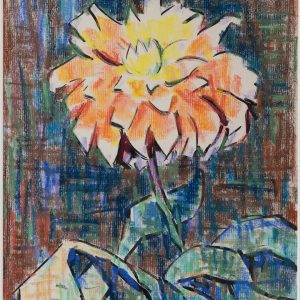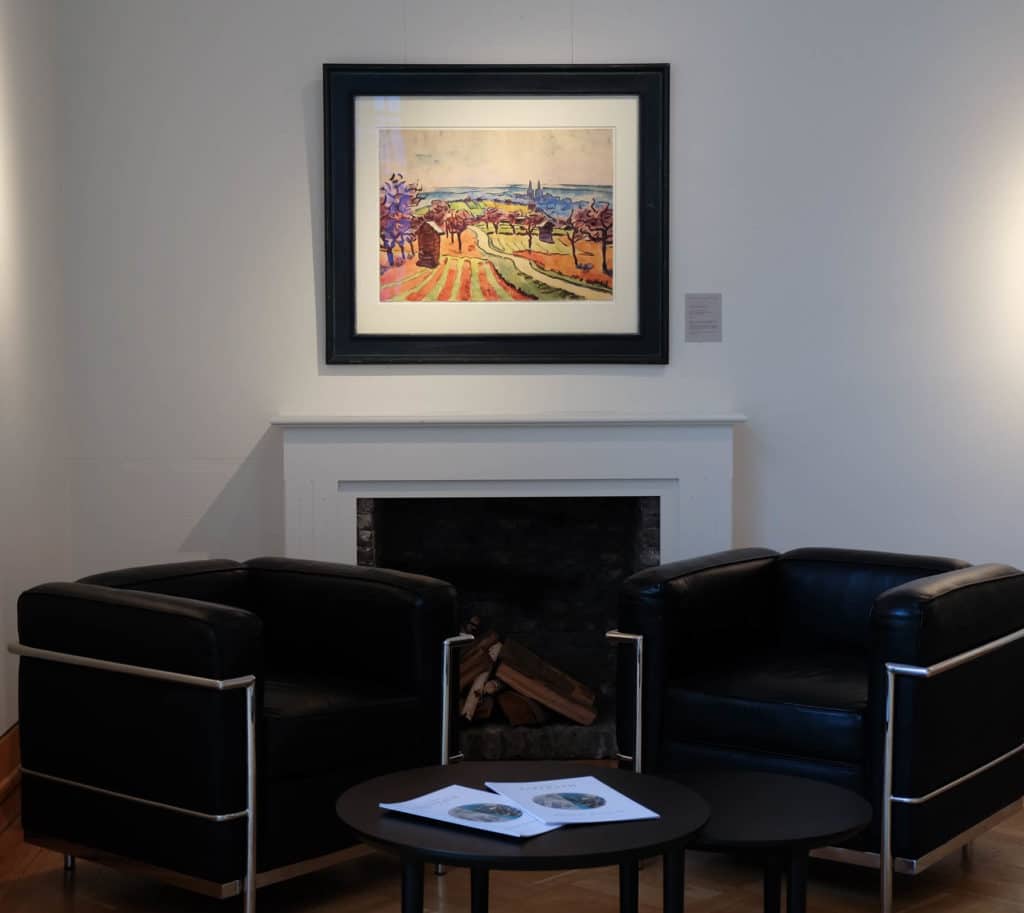
Karl Schmidt-Rottluff
1884 Rottluff near Chemnitz – 1976 Berlin
Short information about the artist
Karl Schmidt-Rottluff is one of the best-known German artists of the 20th century and his work made an important contribution to the development of modern art. His name is closely associated with the Brücke circle of artists, of which he was a founding member and which advocated a new orientation for the arts. His works are characterised by their expressionist style, which is characterised by strong colours and striking contours. His early years in particular are of great importance for his work, as it was during this time that he developed his artistic identity and found his own style.
Today, many of his works can be found in renowned art collections, such as the Museum Barberini in Potsdam or the Kunstmuseum Chemnitz. Exhibitions in Berlin and other German cities also regularly present the work of Karl Schmidt-Rottluff and offer insights into his life as an artist. Rosa Schapire was an important supporter of the artist and helped him to make his works accessible to a wider audience. Despite political difficulties during National Socialism, Karl Schmidt-Rottluff remained faithful to his art and created important works into old age. Today he is regarded as one of the most important representatives of Expressionism in Germany and thus made a significant contribution to the development of modern art.
Kunstwerke im Angebot
Verkaufte Kunstwerke
Videos about the artist
More information about the artist
Karl Schmidt-Rottluff is one of the best-known German artists of the 20th century and his work made an important contribution to the development of modern art. His name is closely associated with the Brücke circle of artists, of which he was a founding member and which advocated a new orientation for the arts. His works are characterised by their expressionist style, which is characterised by strong colours and striking contours. His early years in particular are of great importance for his work, as it was during this time that he developed his artistic identity and found his own style.
Today, many of his works can be found in renowned art collections, such as the Museum Barberini in Potsdam or the Kunstmuseum Chemnitz. Exhibitions in Berlin and other German cities also regularly present the work of Karl Schmidt-Rottluff and offer insights into his life as an artist. Rosa Schapire was an important supporter of the artist and helped him to make his works accessible to a wider audience. Despite political difficulties during National Socialism, Karl Schmidt-Rottluff remained faithful to his art and created important works into old age. Today he is regarded as one of the most important representatives of Expressionism in Germany and thus made a significant contribution to the development of modern art.
The Early Years of Karl Schmidt-Rottluff
In Karl Schmidt-Rottluff’s early years, art was already an important part of his life. In 1905, together with other artists such as Max Pechstein and Ernst Ludwig Kirchner, he founded the Expressionist artists’ group “Die Brücke”. This group revolutionised the art scene in Germany and shaped a new style characterised by vivid colours and a strong emphasis on emotion. In this year Schmidt-Rottluff also appeared in public for the first time with his own works and took part in his first exhibition in Berlin. In the course of 1906, he finally became an official member of the “Brücke” and was thus able to further develop his artistic skills. The first years were marked by experiments and an intensive exploration of different techniques and materials. Some of his important works were created during this period, such as the painting “Rosa Tulpen” (1912) or the woodcut triptych “Lebensalter” (1919). Today, many of these works can be found in renowned art collections, such as the Museum am Theaterplatz Chemnitz or the Karl Schmidt Rottluff House in Berlin.
The Expressionist Style of Karl Schmidt-Rottluff
Karl Schmidt-Rottluff skilfully implemented the Expressionist style in his works. The colours and shapes of his paintings are often distorted and exaggerated to express emotions. His paintings radiate a certain rawness and immediacy that is typical of Expressionism. His woodcuts are particularly impressive, in which he perfected his technique and became a masterpiece of the art form. Karl Schmidt-Rottluff’s exhibitions were a great success and were highly praised by critics. The influence of Karl Schmidt-Rottluff’s expressionist style on the arts can still be felt today, making him one of the most important artists of his time.
The Brücke Circle of Artists and the collaboration with other artists
Karl Schmidt-Rottluff was not only an outstanding artist, but also a member of the Brücke circle of artists. The group, founded in Dresden in 1905, aimed to develop a new formal language through collaboration and exchange with other artists. Schmidt-Rottluff worked closely with other members such as Max Pechstein and Emil Nolde, creating some of the most important works of Expressionism. The Brücke circle of artists also organised exhibitions in Berlin, Chemnitz and other German cities to make their ideas accessible to a wider audience. Even after the end of the circle in 1913, the exchange between the former members continued. Rosa Schapire, a close friend of Schmidt-Rottluff and art expert, organised several exhibitions of his works in various museums and art collections. Collaboration with other artists was of great importance to Schmidt-Rottluff’s creative process and contributed significantly to the success of his work.
Recognition and success in the art world for Karl Schmidt-Rottluff
Karl Schmidt-Rottluff was an artist who made a name for himself in the art world with his innovative and expressionist works. His talent was recognised by many art collections and museums, which led to numerous exhibitions of his works. Particularly significant was his membership in the “Brücke” circle of artists, a group of young, aspiring artists who shaped Expressionism in Germany. Together with other members such as Max Pechstein and Ernst Ludwig Kirchner, he created revolutionary works that are still admired today. Schmidt-Rottluff’s success in the art world is also reflected in the fact that his works were exhibited in important collections such as the Museum of Modern Art in New York or the Städel Museum in Frankfurt. An important role was certainly played by his close circle of friends around the art historian Rosa Schapire, who repeatedly provided him with new opportunities to present his work. Karl Schmidt-Rottluff also received special attention at the major exhibition “Degenerate Art” in 1937 during National Socialism. His works were considered “degenerate” and were removed from public collections – a fact that, however, could not affect his reputation in the long term. All in all, it can be said that Karl Schmidt-Rottluff was a very successful artist despite all political adversities. His innovative techniques and distinctive style have left a lasting impression on art history and continue to inspire many young artists today.
Later years and legacy of Karl-Schmidt Rottloff
In his later years, Karl Schmidt-Rottluff remained active in the art world and continued to shape his works with his distinctive style. An important exhibition took place in 1964 at the Museum am Ostwall in Dortmund, which became known under the title “Karl Schmidt-Rottluff – Zum 80. Geburtstag”. Other exhibitions were also organised at the Max Pechstein Museum in Zwickau and the Chemnitz Art Museum. His legacy is represented by many of his works, which are now in various art collections, including the German Historical Museum and the Rosa Schapire Art Archive in Berlin. Despite the political influence during National Socialism, Karl Schmidt-Rottluff was able to maintain his place as an important artist and his work influenced generations of artists after him.
Exhibitions and collections
During his life, Karl Schmidt-Rottluff had the opportunity to present his works in numerous exhibitions and collections. A significant example of this is the Brücke Museum in Berlin, which is dedicated to the circle of artists and houses an extensive collection of works by the painter. The Gunzenhauser Museum in Chemnitz also shows a remarkable selection of Schmidt-Rottluff’s artworks. As a member of the Brücke, he was also involved in many group exhibitions that helped cement his reputation as an innovative artist. The Deutsche Bank Kunstsammlungen also owns some of his works. Rosa Schapire, an art critic and patron of the Brücke artists, even organised a major retrospective of Karl Schmidt-Rottluff’s works in Hamburg in 1923. This exhibition showed an overview of the artist’s creative years up to that point and helped to make his work accessible to a wider audience. Overall, these important exhibitions and collections clearly show the influence of Schmidt-Rottluff’s art on German arts in the 20th century as well as his importance for the development of Expressionism within the Brücke movement.
